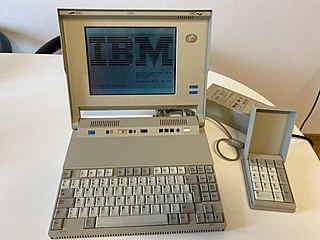Packard Bell Electronics, Inc. was an American computer company independently active from 1986 to 1996, now a Dutch-registered computer manufacturing brand and subsidiary of Acer Inc. The company was founded in 1986, after Israeli-American investors bought the trademark rights to the Packard Bell Corporation from Teledyne. The investors wanted to name their newly formed personal computer manufacturing company producing discount computers in the North American markets.

Gateway, Inc., previously Gateway 2000, Inc., was an American computer company originally based in Iowa and South Dakota. Founded by Ted Waitt and Mike Hammond in 1985, the company developed, manufactured, supported, and marketed a wide range of personal computers, computer monitors, servers, and computer accessories. At its peak in the year 2000, the company employed nearly 25,000 worldwide. Following a seven-year-long slump, punctuated by the acquisition of rival computer manufacturer eMachines in 2004 and massive consolidation of the company's various divisions in an attempt to curb losses and regain market share, Gateway was acquired by Taiwanese hardware and electronics corporation Acer, in October 2007 for US$710 million.

AST Research, Inc., later doing business as AST Computer, was a personal computer manufacturer. It was founded in 1980 in Irvine, California, by Albert Wong, Safi Qureshey, and Thomas Yuen, as an initialism of their first names. In the 1980s, AST designed add-on expansion cards, and evolved toward the 1990s into a major personal computer manufacturer. AST was acquired by Samsung Electronics in 1997 but was de facto closed in 1999 due to a series of losses.

The LTE is a line of laptops manufactured by Compaq Computer Corporation, introduced in 1989 and discontinued in 1997. It was the first notebook-sized laptop sold by Compaq and the first commercially successful notebook computer, helping launch the burgeoning industry.

Mylex Corporation was an American computer company active from 1983 to 1999. The company mainly produced peripherals and expansion cards for personal computers—chiefly the IBM Personal Computer—for the bulk of its existence, although it also produced complete motherboards. In the mid-1990s the company focused on designing and manufacturing RAID controllers, eventually cornering 75 percent of the RAID controller market. In 1999, the company was acquired by and made a subsidiary of IBM for approximately $240 million. In 2002, IBM sold their Mylex division to LSI Logic for an undisclosed amount.

Global Village Communication Inc. was a leading manufacturer of easy-to-use fax modems and other telecommunications products for Apple's Macintosh platform. It was one of the few manufacturers to support the Mac's RS-422 serial ports without requiring an adapter. Major product lines included the TelePort series of high-speed desktop dial-up modems, and the PowerPort series of internal PowerBook modems, as well as a series of modems that connected to the Mac's ADB port. Many of its products were bundled with the Macintosh Performa series of computers, and it was the manufacturer for the internal modem in the PowerBook 500 series.

The IBM Personal System/2 Model L40 SX is a portable computer made by IBM as part of the IBM PS/2 series. It was the successor to the IBM PC Convertible. The "SX" in the name refers to its CPU, the Intel 80386SX.

The PCradio was a notebook computer released by International Business Machines (IBM) in late 1991. Designed primarily for mobile workers such as service technicians, salespersons and public safety workers, the PCradio featured a ruggedized build with no internal hard disk drive and was optioned with either a cellular or ARDIS RF modem, in addition to a standard landline modem.

The Personal System/2 Model 30 and Personal System/2 Model 30 286 are IBM's entry-level desktop computers in their Personal System/2 (PS/2) family of personal computers. As opposed to higher-end entries in the PS/2 line which use Micro Channel bus architecture, the Model 30 features an Industry Standard Architecture bus, allowing it to use expansion cards from its direct predecessors, the PC/XT and the PC/AT. The original PS/2 Model 30 is built upon the Intel 8086 microprocessor clocked at 8 MHz; the Model 30 286 features the Intel 80286 clocked at 10 MHz.

The Personal System/2 Model 25 and its later submodels the 25 286 and 25 SX are IBM's lowest-end entries in the Personal System/2 (PS/2) family of personal computers. Like its sibling the Model 30, the Model 25 features an Industry Standard Architecture bus, allowing it to use expansion cards from its direct predecessors, the PC/XT and the PC/AT—but not from higher entries in the PS/2 line, which use Micro Channel. Unlike all other entries in the PS/2 line, the Model 25 and its submodels are built into an all-in-one form factor, with its cathode-ray tube (CRT) monitor and system board occupying the same enclosure. IBM oriented the Model 25 at home office workers and students.
IBM EduQuest, later shortened to EduQuest, was a subsidiary of American multinational technology corporation IBM that catered to the elementary and secondary educational market. A spin-off of the company's Educational Systems division spearheaded by James Elton Dezell Jr. (1933–2000), EduQuest developed software and hardware for schools. Most prominent was their line of all-in-one personal computers, whose form factor was based on IBM's PS/2 Model 25.

Cardinal Technologies, Inc., was an American computer company originally based in Lancaster, Pennsylvania, that primarily manufactured modems for personal computers, among other peripherals.
Practical Peripherals, Inc., was a private American computer peripheral manufacturer active from 1981 to 1999 and based in Los Angeles County. Founded by Michael Seedman, the company specialized in telecommunications products, primarily modems, for personal computers. Seedman led the company from its inception in 1981 until 1993, after Practical Peripherals was sold to Hayes Microcomputer Products.

Prometheus Products, Inc. was an American computer peripheral manufacturer active from 1981 to 1996. The company primarily manufactured modems and sound cards for personal computers for the bulk of its existence.

Reveal Computer Products, Inc., was a short-lived American computer peripheral manufacturer active from 1992 to 1996. It was established as a subsidiary of Packard Bell Electronics, an American computer company. The company was once a major player in the IBM PC peripheral market, with annual sales peaking above the US$200 million mark. It went bankrupt in 1996 after an aborted $65-million merger with Creative Technology.
Video Seven, Inc., also typeset as Video-7, later Headland Technology, Inc., was a public American computer hardware company independently active from 1984 to 1989. The company manufactured expansion cards for personal computers, mainly graphics cards for the IBM PC through their Vega brand. It was founded by Paul Jain as his second venture in the graphics card market; after his departure in 1990, he founded Media Vision. Video Seven delivered both the first graphics card compatible with IBM's Enhanced Graphics Adapter (EGA), in 1985, and one of the first cards compatible with IBM's Video Graphics Array (VGA) standard, in 1987. In 1989, Video Seven merged with G-2 Inc., a subsidiary of LSI Logic Corporation, becoming Headland Technology.
New Media Corporation, also known as New Media Technology Corporation, was an American computer company active from 1992 to the early 2000s. The company focused on the design and manufacture of PC Cards, a type of expansion card bus for laptops that had their heyday from the early 1990s to the mid-2000s. New Media was privately held and based out of Irvine, California.

STB Systems, Inc., was an American graphics adapter card manufacturer active from 1981 to 1999. Initially a manufacturer of various expansion cards for the Apple II, the company quickly leaned into the graphics accelerator market for IBM PCs and compatibles, owing to the IBM PC's more open architecture. STB went public in 1995 and was once the second-largest global vendor of multimedia computer products. In 1999, the company was acquired by 3dfx Interactive.
Genoa Systems Corporation, later Genoa Electronics Corporation, was an American computer multimedia peripheral vendor based in San Jose, California, and active from 1984 to 2002. The company was once a prolific and well-known manufacturer of video cards and chipsets. They also dabbled in modems, tape drives, sound cards, and other peripheral expansion cards. The company was a founding member of the Video Electronics Standards Association (VESA) and were instrumental in the development of Super VGA.
Micronics Computers, Inc. was an American computer company active from 1986 to 1998 that manufactured complete systems, motherboards, and peripherals. Based in the San Francisco Bay Area, Micronics was one of the largest domestic motherboard manufacturers in the United States in the 1990s. After acquiring Orchid Technology in 1994, the company entered the market for multimedia products, such as graphics adapters and sound cards. In 1998, Micronics was acquired by Diamond Multimedia.














